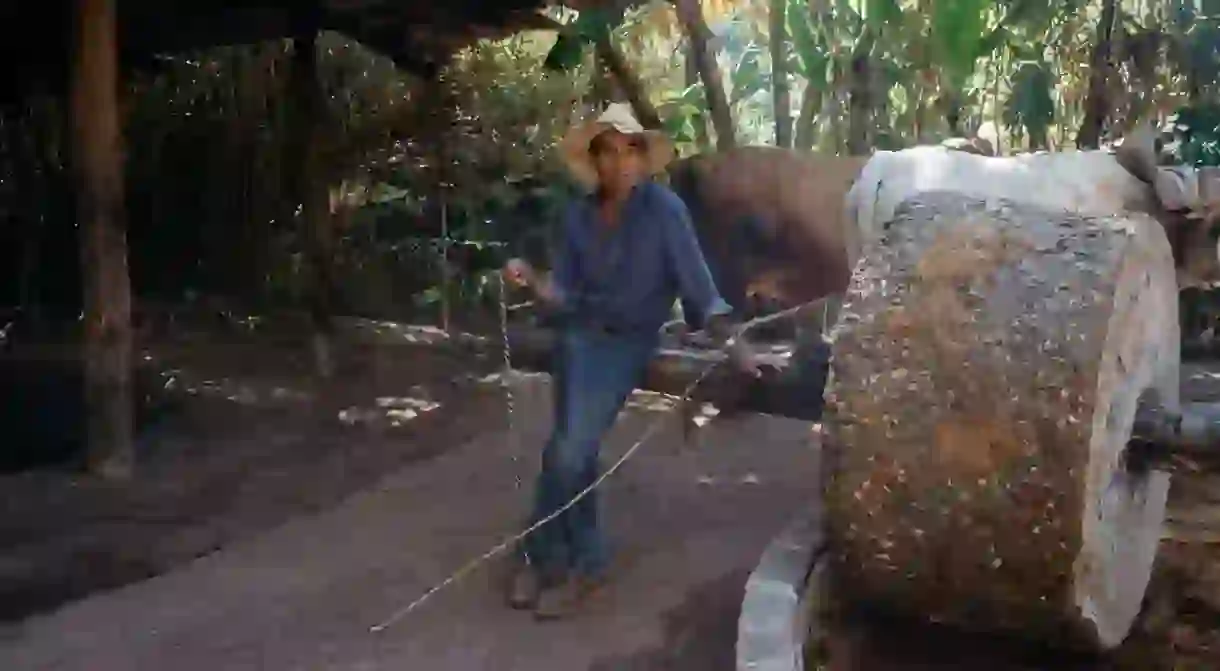A Glimpse into How Mezcal, Mexico's Most Prized Liquor is Made

The sacredness of the agave in Mexico should not be underestimated. For at least 2,000 years this desert plant has dominated Aztec (and then Mexican) culture as a source of clothing, needles, medicine, sweetener and above all – alcohol.


Most of us have had one night or another when we got to know the agave’s most famous product – tequila – really well. But until about the past decade, tequila’s more ancient and traditional brothers – mezcal and pulque – have gotten very little press. We want to get to the heart of the agave so to speak. So along with Melanie Symonds from Quiquiriqui Mezcal, we took a trip out to Ejutla, Oaxaca where the mezcal brand Marca Negra is produced to discover the ancient magic of mezcal making for ourselves.

Agave plants are family to the Joshua tree and the yucca, and are not, as we are often told, a cactus. The plants live anywhere from 25 to 30 years, flowering only once in the form of a single flower that shoots off the end of a long stalk in the center of the plant. Once an agave flowers, it begins its slow march towards death, but agave used for mezcal (and tequila) have been harvested long before that can happen.

Agaves destined for mezcal are harvested at around seven or eight years old, the outside spines cut off leaving only the plant’s sugar-rich and dense heart or as it is called in Spanish, piña (a nod to the fact that it looks like a pineapple once cut).


Agave hearts are then roasted in a stone or brick-lined pit called a palenque or horno. These pits can be up to 15 feet across and eight feet deep and are conical-shaped. The pit is previously prepped by building a fire in its deepest depth and covering that fire with flat stones. Once those stones are red hot, the piñas are placed on top and covered with agave leaves, straw mats and earth and left to roast for several days. Roasting time is determined by climate and the mezcal master’s own individual recipe.

At this point the mixture is comparable to agave beer and it’s put in either a copper or clay still, the clay adding a bit of minerality to it. After the liquid goes into the still, it comes out about 20-30% alcohol, it is then distilled again and comes out closer to mid-50%. The most important job in the process is that of tasting done by the mezcalero, who determines if it needs another distillation.

The versatility of mezcal making, as well as its traditional, low-tech distilling and fermenting process, means the industry is still mostly small producers with small batch mezcals that display a unique combination of the agaves used, the air and soil of a particular area, and the accumulated knowledge of traditional producers.


Differentiating it from tequila, which can only be made with the blue agave plant variety, mezcal is an equal opportunities spirit. This liquor can be made from a wide range of agave plant varieties meaning distilleries small and large exist across the country. Tequila is only recognized as made in seven states by the Mexican government.


Deep inside the palenque, the piñas sugar content causes them to caramelize and the air fills with the heavenly scent of burnt sugar. That classic smokey flavor that you taste when you sip a mezcal is imbued in the plant at this moment in the process.

Once removed, the piñas are a golden brown and they are placed on a donkey or horse-drawn stone mill where they are crushed into a mud-brown pulp. Usually a man works alongside the animal (or tractor in large distilleries) working the mill to mix and move the piñas, ensuring an even grinding.





The mash is then put in wooden barrels and covered in hot water to ferment for several days. Then the process is repeated with cold water. Fermentation times depends on the climate and region where the mezcal is being made – high temperatures mean faster fermentation.



Once fermented, the mash and the liquid is moved into a still (usually copper) for the first distillation process. Depending on the individual producer and the type of mezcal, the liquid can be distilled one or two additional times. The mezcal is then moved into oak barrels for the aging process.


Young mezcal, called joven in Spanish, spends minimal time in oak barrels (from zero to two months). These mezcals have the most intense flavors and tend to most strongly present the herbs, minerals, salts and other natural flavors of the soil and environment of their origin.

Resposado mezcal is aged from six months to a year and generally has a much smoother flavor than joven mezcal. In reposado mezcal you will find the beginnings of an oaky flavor added by its time in barrel.
Añejo mezcal has been aged a year or more in oak barrels by the time it touches your lips and has the smoothest, most caramelized flavor of all three types. If you get the opportunity, definitely try all three types as you travel throughout Mexico. Salud!














